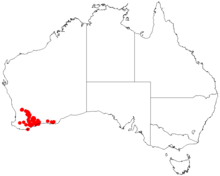Acacia mimica is a shrub of the genus Acacia and the subgenus Plurinerves that is endemic to south western Australia.
| Acacia mimica | |
|---|---|
| Scientific classification | |
| Kingdom: | Plantae |
| Clade: | Tracheophytes |
| Clade: | Angiosperms |
| Clade: | Eudicots |
| Clade: | Rosids |
| Order: | Fabales |
| Family: | Fabaceae |
| Subfamily: | Caesalpinioideae |
| Clade: | Mimosoid clade |
| Genus: | Acacia |
| Species: | A. mimica
|
| Binomial name | |
| Acacia mimica | |

| |
| Occurrence data from AVH | |
Description
editThe dense shrub typically grows to a height of 0.3 to 2.5 metres (1 to 8 ft)[1] and can have an erect or semi-prostrate habit with glabrous to hairy branchlets. Like most species of Acacia it has phyllodes rather than true leaves. The patent to erect, rigid to leathery, grey-green and glabrous phyllodes have a narrowly elliptic or linear to oblanceolate-linear shape that is curved with a length of 1.8 to 10.5 cm (0.71 to 4.13 in) and a width of 2 to 7 mm (0.079 to 0.276 in) with many raised and irregular closely parallel nerves and prominent yellow marginal nerves.[2] It blooms from July to October and produces yellow flowers.[1]
Taxonomy
editThere are two recognised varieties:
- Acacia mimica var. angusta
- Acacia mimica var. mimica
The yellow nerves on the plant make it similar in appearance to Acacia patagiata.[2]
Distribution
editIt is native to an area in the Wheatbelt, Great Southern and Goldfields-Esperance regions of Western Australia where it is commonly situated on undulating sandplains, rocky ridges and hills and rises growing in clay, loam or sandy soils that can contain gravel.[1] The range of the plant extends from around Goomalling in the north west down to around Borden in the south east and then out as far as Raavensthorpe in the east with outlying population found near Scaddan and Mount Burdett even further to the east.[2]
See also
editReferences
edit- ^ a b c "Acacia mimica". FloraBase. Western Australian Government Department of Biodiversity, Conservation and Attractions.
- ^ a b c "Acacia mimica". World Wide Wattle. Western Australian Herbarium. Retrieved 17 December 2020.